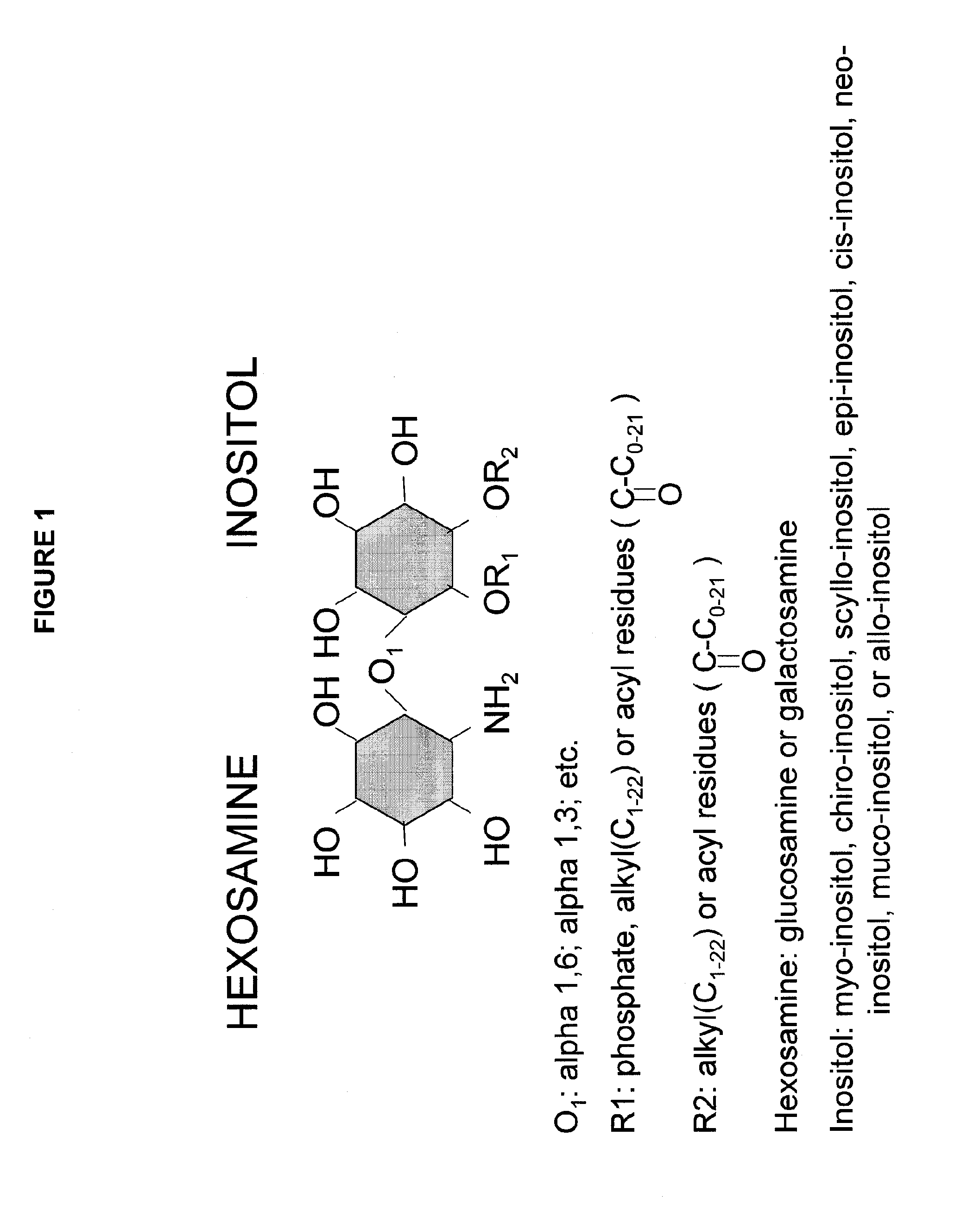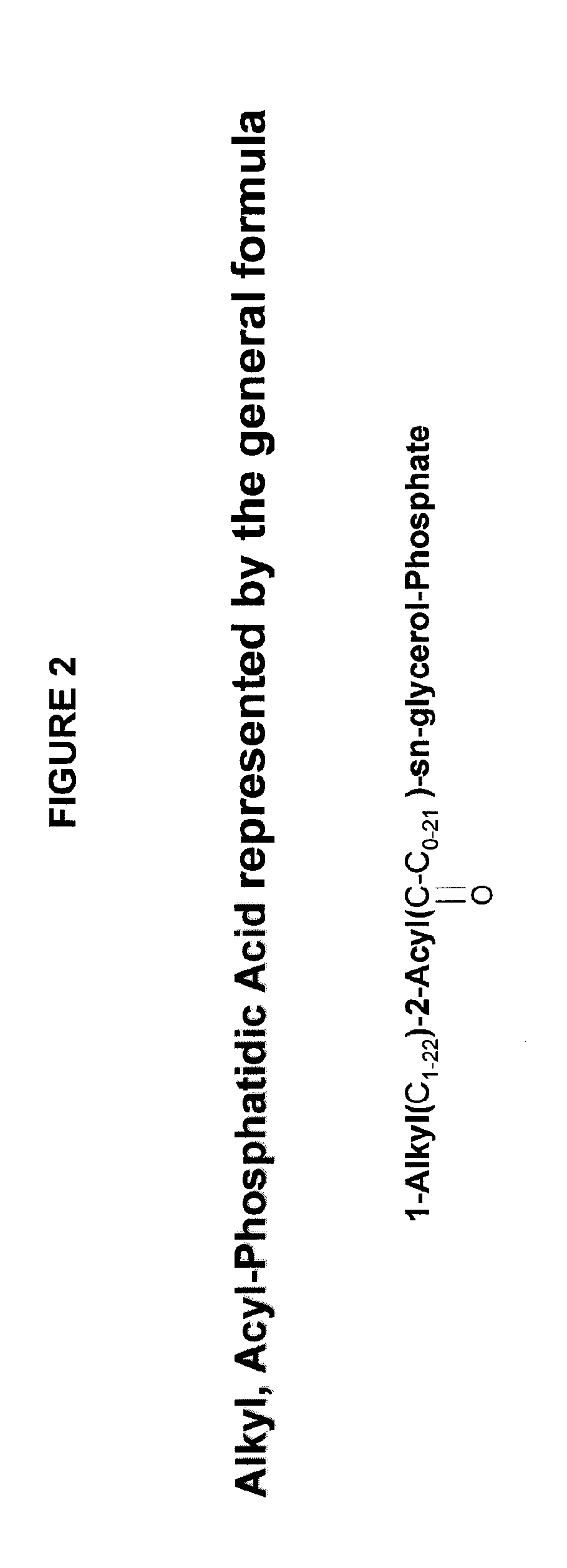[0011]In some embodiments of the invention, the lipophilic
inositol glycan compounds of formula (I) and (II), and salts, solvates and physiological functional derivatives thereof, are co-administered with other agents or therapies. In another aspect, the lipophilic inositol glycan compounds of formula (I) and (II), and salts, solvates and physiological functional derivatives thereof, can be co-administered with on or more
alkyl, acyl-
phosphatidic acid (AAPA) compounds.
Alkyl, acyl-
phosphatidic acid (AAPA) is a putative product from glycosylphospatidylinositol (GPI) precursor of IG-1 by the
hydrolysis with GPI-specific
phospholipase D (GPI-PLD). In preferred embodiments, AAPA compounds are selected from the compounds of formula III:1-
Alkyl(C1-22)-2-Acyl(O═C—C0-21)-sn-
glycerol-
Phosphate (III)AAPA compounds also include and salts, solvates and physiological functional derivatives thereof. Non-limiting examples of
alkyl, acyl-
phosphatidic acid (AAPA) compounds include AAPA1 (1-0-
alkyl (18:0)-2-0-acyl-(18:0)-sn-
glycerol-
phosphate), AAPA2 (1-0-alkyl (18:0)-2-0-acyl-(20:4)-sn-
glycerol-
phosphate) and AAPA3 (1-0-alkyl (18:0)-2-0-acyl-(22:4)-sn-glycerol-
phosphate). In preferred embodiments, co-administration results in synergistic effects.
[0014]In another aspect, the invention provides a method of reducing cellular proliferation comprising the step of exposing said cells to an effective amount of a lipophilic inositol glycan compound, or functional analogs or isomers thereof. The cellular proliferation can be associated with cancer. In a preferred embodiment, the cells are located
in vivo in a subject. In other aspects, the one or more compounds of the present invention can be used to slow or ameliorate abnormal cellular proliferation of cancer cells.
[0019]The ability to induce
apoptosis of cancer cells is a desirable feature of anticancer agents. The ability to induce
apoptosis in cancer cells, without affecting healthy cells, as well as minimizing side-effects are major goals for the development of new anticancer agents. Experiments conducted during the course of development of the present invention indicate that lipophilic inositol glycan reduces
cell proliferation, and induces rapid
cell death in cancer cells, such as, for example, human
pancreatic cancer cells, human hepatoma cells, human gastric cancer cells,
human colon cancer cells, and human mammary cancer cells. In contrast, the lipophilic inositol glycans do not affect normal cells.
[0021]In another aspect, the invention encompasses a method for treating or preventing cancer in a patient in need thereof, comprising administering to the patient a therapeutically or prophylactically effective amount of a formula I or II compound, or salts, solvates and physiological functional derivatives thereof, and at least one additional therapeutic agent. In preferred embodiments, a therapeutically or prophylactically effective amount of a formula I or II compound, or salts, solvates and physiological functional derivatives thereof, is co-administered with one or more AAPA compounds of formula (III), or salts, solvates and physiological functional derivatives thereof. This co-administration can produce a synergistic effect. In other embodiments, at least one additional therapeutic agent can be combined with the co-administration.
[0023]In another aspect, the lipophilic inositol glycan compounds of formula (I) and (II), and salts, solvates and physiological functional derivatives thereof, can be used in the treatment of glucose-
metabolism disorders. Glucose-metabolism disorders include, but are not limited to,
obesity, diabetes, metabolic syndrome,
insulin resistance, glucose intolerance, hyerinsulinemia,
Syndrome X, hypercholesterolemia, hyperlipoproteinemia,
hypertriglyceridemia, atherosclerosis, and
diabetic renal disease. For example, the lipophilic inositol glycan compounds are useful in the treatment of type 2 diabetes, a
disease which is associated with
insulin resistance in
peripheral tissues and impaired glucose-stimulated
insulin secretion from pancreatic beta-cells and elevated hepatic
gluconeogenesis. The lipophilic inositol glycan compounds have been shown in the Examples to increase
lipogenesis in adipocytes, and reduce
plasma glucose concentrations in mice with
high fat diets, as well as STZ-diabetic mice. Furthermore, the lipophilic inositol glycan compounds can be used to control glucose homoeostasis. As shown in the Examples, treatment with lipophilic inositol glycan compounds for 28 days significantly reduced daily
food intake,
body weight, and fasting
plasma concentrations of insulin,
triglyceride, free fatty acids and
leptin in ob / ob
obese mice and the C57B / 6 mice on high-fat diets.
 Login to View More
Login to View More 


